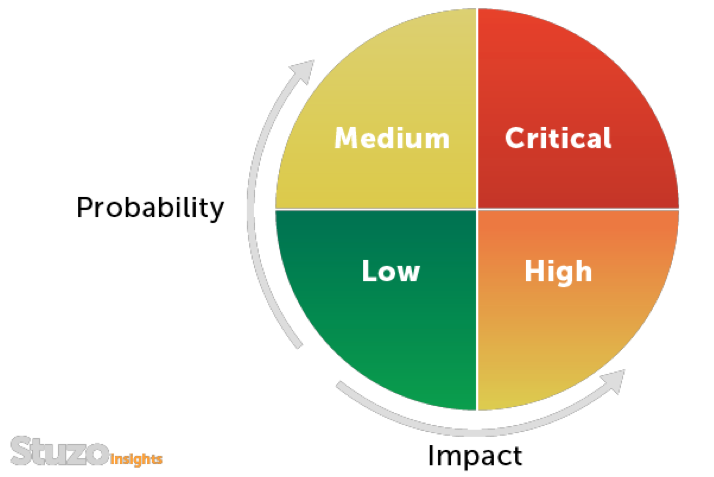Projects are fun and project management is too. Many outsiders to project management looking in sometimes don’t realize the skills and management techniques a successful project manager employs to deliver a quality project. In this post, I am going to cover the aspect of risk and risk management during the life cycle of a project and how it can result in a better product, happier team, and satisfied client.
While each project does present its own set of challenges and opportunities, there are many common themes across interactive projects related to risk. Recognizing these commonalities and adopting project and account management practices to address them will help minimize the impact a potential risk may have on a project. Ultimately, it’s a project team’s overall goal to keep a project on time, on budget, and at a superior quality level that executes against the key objectives. If we can implement efficiencies to keep projects under time and under budget, that is always a plus. Recognizing risks and developing solution plans are great ways to ensure success measures are met and, often at times, exceeded.
How many of you have worked on a project where a new & innovative technical feature was being implemented for the first time? How about a project where the timeline was moving so fast, a delay in creative delivery could jeopardize the project? With the proliferation of web technologies, how about encountering a new web service, which presents implementation uncertainties? You are not alone, these are common risks identified during an interactive project.
Risk always exists in a project. Whether the project is being managed by a 20 year PMP certified veteran or a newly minted project manager, there will be risks in the project. A risk could be an employee concern, technical limitation, timing issue, or even a client-side unknown among many other reasons. Now, that we have that part out of the way and acknowledged that risk is always part of a project, how do we keep it from looming over our shoulders and catching us at an inopportune time?
Get to love risk early on in your project. I know this might sound crazy for those not in this role, but this helps you avoid bigger problems down the road. Risk assessment should be included as a step in the early stages of internal project preparation. This requires a very open and honest mind-set from the team members involved. It’s critical not to let over confidence get in the way of fully engaging in this part. As a project manager, providing the necessary openness and humility to complete this step will allow your project stakeholders around you to embrace a similar approach to addressing risk issues.
Talk about the risks. Doing so, will allow you to tap into the knowledge of your supporting team, which often times decreases the initial assumed magnitude of the identified risks off the bat. Through communicating you will also become comfortable with eloquently describing and documenting the risk. You will find support across your team and tap into subject matter experts that will make your life much easier. It’s recommended to leverage the best tools available for your organization to effectively participate in the communication stream on risks while still being engaging. Whether you use a tool to do so or open brainstorming along the way, it’s the initial acceptance and mentality that drives a successful risk management process.
Document the risk and ensure an owner is assigned. Now that you have understood and communicated the risk early on, you may feel a little uneasy as project managers are often already thinking of the project, requirements and deadlines ahead. It’s ok. This feeling will pass. Developing a risk resolution / mitigation plan with an identified risk owner at this stage allows you to leverage your best assets who will be going through the journey with you – your project stakeholders. As added advantages to distributing ownership of the risks to the best suited, you also provide team and individual accountability measures, which over time build camaraderie, expertise, and respect in the workplace.
Finalize the assessment and develop solution scenarios. Understand the implications of each risk and prioritize based on this knowledge. Some risks may have a quick resolution plan, while others may require significant time investment. It’s important to understand the possible effects of a discovered risk in a quantifiable way. Could it take you dramatically over budget? Over time? Require pulling additional resources? Will you need to modify the work back schedule and re-brief the client? Understanding the implications and quantifying will help prioritize and align the entire internal (and sometimes client-side) team for the next stages of the project. When involving the client-side, it helps support with managing expectations, building trust, and leads to a great working relationship. The involvement required, really depends on the risks being determined.
To support with the prioritization there are some common buckets risks can be placed in to help understand the possible severity level by weighing the risk impact and probability:

Agree on the solution scenario decision, take action, and control the risk. Risks identified may go down a series of solution scenario options. For one risk – there may be multiple methods to achieve what we recognize as a “resolution” and it’s critical for the project manager to align and understand the resources, timing, costs, and impact of each scenario before agreeing to a final direction. Different stakeholders will have their own viewpoints on the solution, and it’s critical for a project manager to drive the final decision and communicate direction, while fairly weighing the team’s assessment options. Through the control stage, you may be able to reduce the risk’s probability and/or impact by taking some measures, avoid the risk altogether by changing direction, or lay in a plan which entirely resolves the risk. There may also be some risks with lower probability or lower impact, which may not be acted on, depending on the project scenario.
Share and learn across the organization. It’s critical that learnings from these scenarios are discussed and shared appropriately across the organization. Depending on the company, this may be in a project post-mortem, wiki, account debrief, company collaboration software, or a combination of these. Whichever avenue you choose, it’s important to hold a review of the project with the stakeholders while it is still fresh in the team’s mind and all final information can be documented and shared with a hive-minded team approach.
There is also information that should be clearly shared back to the sales team, account managers, or those responsible for delivering the work into the project team’s hands and interfacing with the client. This helps establish a workflow and knowledge sharing approach to help lessen the probability of reoccurrence of these risks over-time. And by doing this, if they do come into play again in a future project, this provides a means in which others can tap into these learnings for efficient resolutions. Your clients and team will thank you for this approach as it mitigates the probability of these risks on future projects.
Celebrate the success! Risk is not a negative word. The ability to analyze and develop solution strategies with a socially calibrated team around risks is quite an accomplishment. It’s important to recognize the failures and successes along the way. You will find projects coming in under time and unlocking new opportunities for your clients. Be sure to give the team members who helped along the way a big thank you (and maybe a beer) and recognize the achievements you have made together.
At the end of the day, have fun with your projects! Each new risk brings a new opportunity to learn, grow, and improve skill-sets across the team.





